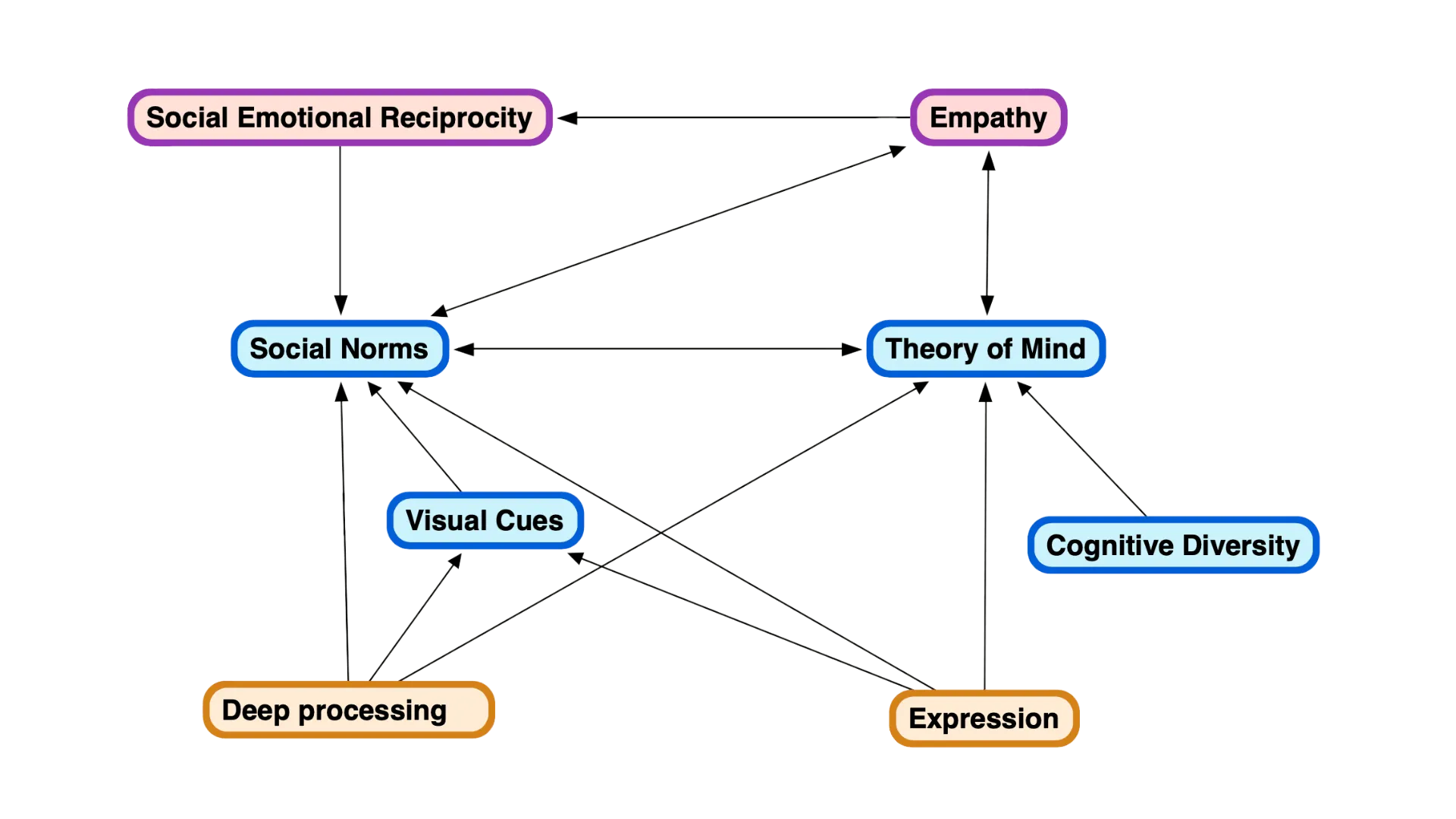A Model of Social Interaction: Overview

Part A of the diagnostic criteria for autism is about social communication and interaction. But a diagnosis provides few, if any clues as to why the autistic person struggles with social interaction. There is no explanation regarding which parts of social interaction are working fine and which parts are not working as well as they should. Aspiedent has written about the barriers to social interaction in autism, but it is difficult to fully explain without a comprehensive model of the key elements of social interaction.
In this article, we present an overview of a new proposed model of social interaction. In subsequent posts, we will go into this model in more detail. The diagram above depicts the elements of our model of social interaction. It has been divided into three parts.
The pink boxes denote the emotional aspect of social interaction. This is key for building emotional connection.
The blue boxes denote the knowledge that is required for effective social interaction. While elements of this can be taught, the bulk of the knowledge is acquired throughout childhood and modified and added to throughout life. Interaction with other people is key for developing this knowledge, though some of it can be taught.
The orange boxes denote the requirement to be able to fully understand and process what is said to you as well as to be able respond appropriately. In autism, there are issues with one or both of these boxes.
Emotion
The emotional aspect of social interaction is what makes this activity enjoyable and fulfilling for most people. Social chit chat is mostly about the exchange of emotion rather than the meaning of the words. Many people find online meetings more difficult and less satisfying than face to face meetings because the emotional aspect is missing. Emotion is sensed directly and cannot travel down wires.
Empathy enables shared emotions of both sadness and joy. It enables emotional support when people are going through difficult times and shared rejoicing at good news. This is vitally important to create the ‘bonds’ that hold people together and which create social cohesion.
Social Emotional reciprocity involves exchanging packets of emotion during conversation. It builds social connection when people are just talking about normal things, even the weather, and there is no need for emotional support.
The difference between empathy and social emotional reciprocity becomes clear in those autistic people who can empathise but who cannot engage in social emotional reciprocity. These autistic people can empathise with you when you need it (the emotion part, not necessarily with words), but during normal social chit chat, they come across as cold and uninterested because they can’t do the exchange of emotion necessary for social emotional reciprocity.
Knowledge
Much knowledge about culture, about accepted behaviour in different circumstances, about people in general is required to engage effectively in social interaction. Social Norms and Visual Cues relate to the wider context of social interaction. Theory of Mind and Cognitive Diversity relate to knowledge that applies to individuals.
Social Norms are complex because they are situational and context dependent. The person or people you are talking to form part of the context. They vary depending on whether you are with clients, with colleagues, seeing a doctor, with your partner, with your wider family, etc, as well as according to the location. Even when you are with the same people the social norms are different when you are in a restaurant to when you are at a family gathering in someone’s home, or relaxing on a beach together.
Visual Cues are the hand movements, exaggerated movements such as rolling of the eyes or raising of the eyebrows, gaze directions etc that form part of social communication to emphasise points or communicate without words.
Theory of Mind is essentially understanding of people. Understanding that they have different perspectives, different experiences, different knowledge about various situations, different personalities, different likes and dislikes. It is about being able to put yourself ‘in someone else’s shoes’.
Cognitive Diversity is understanding that different people think in different ways and may perceive the world differently. This leads to adapting your style of communication to the person you are speaking to. Those people who are good at this are able to to communicate effectively with anyone.
Participation
If you cannot understand what people are saying and/or struggle to voice your thoughts, standard social communication will be beyond reach.
Being able to engage fully with social norms means being able to process beyond the literal meaning of what is said to hidden meanings, and picking up on irony and sarcasm. As well as understanding the words, you also have to be able to pick up on the other social cues which include emotion and visual cues.
Then once you have processed all this, you must be able to articulate your thoughts while taking everything else into account and providing appropriate emotion and visual cues.
Conclusion
Social interaction is a very complex activity involving many interacting parts. Most people learn this through interacting with other people. But people vary a lot in their ability to do all this. Some people are very proficient at social interaction and have lots of friends and acquaintances. They seem to be able to get on with everyone. Others prefer to have fewer friends that are similar to them and spend more time doing other activities.
Social interaction is such a highly complex skill. It is more surprising that so many people learn it to an acceptable level, than it is that some people struggle with various aspects of it.
While there are many courses that aim to help participants improve their social interaction skills, we would suggest that a better understanding of social interaction would make these courses more efficient and enable more people to benefit.